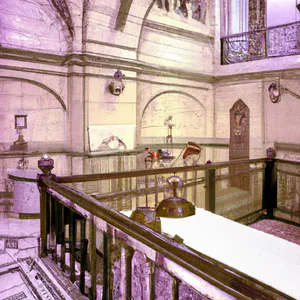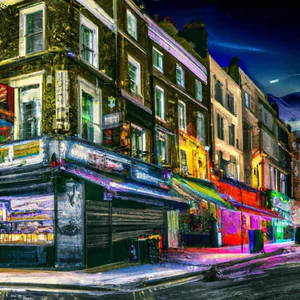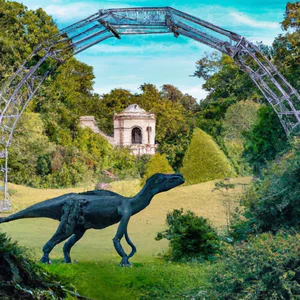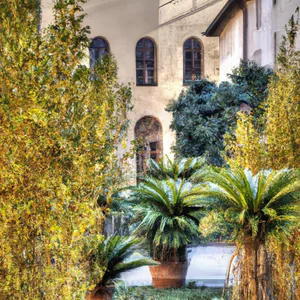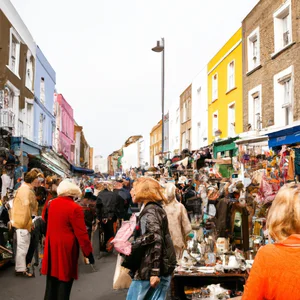Book your experience
Dr Johnson's House: where the first English dictionary was compiled
So, let’s talk about a really interesting place, which is Dr. Johnson’s house. Which, for those who don’t know, was the cradle of a masterpiece: the first English dictionary. Yes, that’s right! Imagine a guy who, in 1700, stood there, with a pen in his hand and a lot of words to catalogue. It’s a bit like trying to organize a wardrobe full of clothes, right?
The house is located in London, and to be honest, when I went there, I felt like an explorer in the past. The walls talk, and I’m not exaggerating! Can you imagine Dr. Johnson walking around those rooms, surrounded by books and rolls of paper, while he tried to put together a dictionary that would change the world? It’s a bit like trying to cook a complicated dish without having the recipe, if you think about it!
The thing that struck me most was the atmosphere. In there, it almost feels like breathing history, with every corner telling something. It is a place that, in my opinion, is really worth visiting if you are passionate about literature or, simply, if you like fascinating stories. And, who knows, maybe you might even feel inspired to write your own dictionary of the words you love most!
In short, in short, Dr. Johnson’s house is truly a unique place. If you’re in London, I recommend you pop in. You may find that history is not only in books, but also in places like this, where the past and present are intertwined in surprising ways. And, among us, who doesn’t love a bit of historical magic?
Dr Johnson’s House: a journey through time
The story behind Dr Johnson’s House
When you cross the threshold of Dr Johnson’s House, you feel like you’ve been catapulted into an era where words carried incredible weight and culture was nourished by lively conversations. The first time I visited this historic home, I felt like an explorer in the depths of 18th century London. Every corner told stories of a man who, with his pen and his tenacity, helped shape the modern English language. I remember admiring his work table, a simple wooden piece of furniture, and imagining the hours spent writing and rewriting definitions, while the light filtered through the windows overlooking a street that today is vibrant with life.
A treasure of history and culture
The house, located at 17 Gough Square, is a stunning example of Georgian architecture and a haven for lovers of literature. Here, between the red brick walls, Dr. Samuel Johnson collected the knowledge of an entire era. His work, the Dictionary of the English Language, not only defined words, but also captured the zeitgeist, becoming a vital tool for linguists and writers. Its publication in 1755 represented a time of enlightenment and change, profoundly influencing the way we think and communicate.
An insider tip
A little-known tip: during your visit, ask your guide to tell you about “Johnson’s Nights,” literary events that took place in the house. These meetings were not only opportunities for cultural debate, but also opportunities for young writers to get noticed. Participating in one of these events would be like going back in time and finding yourself discussing with the intellectuals of the time.
The cultural importance of the house
Dr Johnson’s House is not just a museum; it is a symbol of cultural resistance. In an era when English was still finding its identity, Johnson pioneered a more inclusive and rich language. His legacy lives not only in the dictionary, but also in the way we today view language as a means of expression and identity.
Sustainability and responsibility
Visiting Dr Johnson’s House is also an opportunity to reflect on how we can practice responsible tourism. The house promotes eco-friendly initiatives, such as using sustainable materials for maintenance and reducing plastic at events. Supporting places that adopt these practices helps preserve our cultural heritage for future generations.
An unforgettable experience
During your visit, don’t miss the opportunity to attend one of the poetry readings that are often organized in the garden of the house. Imagine sitting within the same walls that welcomed the great thinkers of the past, while the beauty of the words envelops you like a warm hug.
Myths and reality
A common misconception is that Dr. Johnson was a solitary, introverted man. In reality, he was a lively conversationalist and a trusted friend of many intellectuals of the time. The house bears witness to a time when ideas were exchanged like precious coins, and this community spirit lives on in the events held today.
A final reflection
As you leave Dr Johnson’s House, ask yourself: What is the power of words in your life? The house is not just a monument to history, but an invitation to explore how language can connect, transform, and enrich us. The next time you open a book or write a letter, remember that words, like Johnson’s, can change the world.
Exploring the first English dictionary: a linguistic masterpiece
A personal journey into the language
I still remember the first time I flipped through a copy of Samuel Johnson’s A Dictionary of the English Language. The yellowed pages, the elegant calligraphy and the terms that intertwined in a fascinating mosaic of meanings catapulted me into an era when the English language was starting to find its identity. At that moment, I realized that I wasn’t just reading a book: I was exploring the roots of a culture that influenced the entire world.
A linguistic masterpiece
Published in 1755, Johnson’s dictionary is not just a work of reference, but a true monument to the English language. Considered the first comprehensive dictionary of the language, Johnson’s work laid the foundation for modern lexicography. With over 40,000 entries and definitions, he not only cataloged existing words, but also helped establish the rules and conventions for the use of English. His attention to nuance and use of literary quotations make this dictionary a masterpiece of language and culture.
Insider curiosities
A little-known curiosity is that Johnson himself often employed a humorous approach in his definitions. For example, for the word lexicographer, Johnson wrote: “A dictionary maker, a man who tries to define language, but ends up being defined by the same creation as him.” This playful spirit is a testament to his love of language and his ability to see beyond the mere meaning of words.
The cultural impact
Johnson’s dictionary had a lasting impact not only on the language, but also on Anglo-Saxon culture. He helped standardize English, making it more accessible and understandable for future generations. His work has inspired writers and intellectuals, giving rise to a movement towards the valorization of language as a tool of cultural expression and identity.
Sustainability in linguistic tourism
When you visit Dr Johnson’s House, remember to adopt sustainable practices: he uses public transport to reach the house and takes part in walking tours that allow you to discover not only the history, but also the surrounding architecture. This way, you can appreciate the beauty of London without leaving a heavy ecological footprint.
Soak up the atmosphere
Walking through the rooms of Dr Johnson’s House, you can almost hear the echoes of his reflections and conversations. Every corner tells stories of literature and thought critical, while the period furniture and original furnishings transport you back in time. The atmosphere is imbued with a deep reverence for the written word, making each visit an almost sacred experience.
An activity worth trying
For an authentic experience, attend one of the poetry readings or creative writing workshops held in the house. These activities not only celebrate Johnson’s legacy, but also give you the opportunity to interact with other literary enthusiasts.
Myths to dispel
A common misconception is that Johnson’s dictionary was a simple collection of words. In fact, it is a work of linguistic art that reflects the complexities and riches of English. Johnson didn’t just define the words; he contextualized them, exploring their etymology and use throughout history.
Final reflection
As I think about Samuel Johnson’s extraordinary legacy, I wonder: How will the words we choose today shape the culture of tomorrow? Language is alive, changing, and evolving, just like us. Starting this journey at Dr Johnson’s House is just the first step in understanding the power of words and their lasting impact on our daily lives.
Georgian architecture: elegance to discover
A journey between history and beauty
I still remember the first time I crossed the threshold of Dr Johnson’s House. The atmosphere was imbued with a serene elegance, as if time had stopped. The Georgian architecture, with its clean lines and refined details, captivated me. As I explored the rooms, every corner seemed to tell a story, an anecdote, a thought of the great doctor who lived and worked here. The beauty of this house is not only in its interior, but also in its facade, characterized by red bricks and arched windows, which reflect the style of the era in which it was built.
Practical information and local sources
Dr Johnson’s House, located in the heart of London, is a stunning example of Georgian architecture, dating back to the 1700s. The house is open to the public and offers guided tours that highlight the architectural and historical features. It is advisable to book your ticket in advance, especially on weekends, to avoid long waits. You can find more information on the official website: Dr Johnson’s House.
An insider tip
If you have the opportunity to visit Dr Johnson’s House, do not miss the opportunity to sit in the internal garden, a hidden corner of tranquility. Here, away from the bustle of the city, you can enjoy a moment of reflection, imagining the great doctor who walked in the same space. This is a little-known place even to Londoners themselves, but it turns out to be an oasis of peace.
Cultural and historical impact
Georgian architecture is not just an aesthetic; represents a period of great change for London and the whole of England. With its focus on symmetry and harmony, this style reflected the values of the Enlightenment. Johnson’s house, in particular, is a symbol of how literary culture and design can merge to create a lasting legacy. Each visit is an opportunity to understand not only Johnson’s life, but also the social and cultural context of his time.
Sustainability and responsible tourism
Respecting the architectural and cultural heritage, Dr Johnson’s House promotes sustainable tourism practices. A responsible approach that includes respect for the environment and local history is encouraged. Participating in guided tours and activities that enhance cultural heritage is one way to help keep this architectural jewel alive.
Immerse yourself in the atmosphere
As you move between the rooms, let yourself be enveloped by the charm of the past. The walls, adorned with portraits and works of art, tell of a time when intellect and art were intertwined. The light fragrance of the beeswax used to preserve the furniture will transport you to an era where attention to detail was essential.
Activities to try
After your visit, I recommend exploring the nearby Borough Market, where you can enjoy local foods and artisan products. Here, historic architecture merges with the liveliness of a modern market, creating a unique atmosphere. A perfect way to end the day.
Myths to dispel
A common misconception is that Georgian architecture is only for history lovers. In reality, its aesthetic beauty and cultural importance can fascinate even those who have no particular inclination for the past. In fact, every visitor can find something significant in these elegant structures.
Final reflection
As you leave Dr Johnson’s House, ask yourself: How does architecture impact our perception of history? Every building tells a story, and every visit is an opportunity to connect with the past in a way that enriches the present. Visit this corner of London and discover for yourself the timeless elegance of Georgian architecture.
A guided tour that reveals hidden secrets
A personal experience
I still remember the moment I walked through the door into Dr Johnson’s House. Light filtered through the sash windows, and the air was filled with a palpable sense of history. As I joined a guided tour, our guide’s passionate voice transported me back in time, revealing not only the life of Samuel Johnson, but also the many secrets that lie within the walls of this fascinating Georgian palace. Every corner told a story, and every story was an invitation to explore deeper.
Practical information
Guided tours of Dr Johnson’s House are held regularly, with online booking available. I recommend visiting the house’s official website for updated timetables and ticket details. The expert and engaging guide will delight visitors with little-known anecdotes and unexpected curiosities. Don’t forget to ask about the house’s architectural secrets, which often go unnoticed by the most distracted tourists.
An insider tip
Insider tip: Don’t miss the chance to visit the library on the second floor, which houses a collection of rare editions and manuscripts related to Johnson and his era. Many visitors tend to overlook this corner, but here you can really feel Johnson’s cultural influence on English literature.
Cultural and historical impact
The tour doesn’t just chronicle Johnson’s life; it also offers a broader look at the cultural context of the 18th century. The house is a symbol of the intellectual ferment that characterized the era, a period in which literature and literary criticism were experiencing a true rebirth. His work, the first dictionary of the English language published in 1755, had a lasting impact on the Anglo-Saxon language and culture.
Sustainable tourism practices
Encouraging responsible tourism practices is essential. Taking walking tours, such as those of Dr Johnson’s House, not only offers a more authentic experience, but also helps reduce your environmental impact. Furthermore, many tourers are advised to use sustainable means of transport to reach the house, such as bicycles or public transport.
Atmosphere and immersion
Imagine walking along one of London’s cobbled streets, surrounded by historic buildings and the lively buzz of the city. Upon entering Dr Johnson’s House, the atmosphere is full of history and literature. The walls are adorned with portraits and ancient volumes, and the smell of aged wood and paper takes us back in time, making the tour an immersive experience.
Suggested activity
After the tour, there I recommend walking in nearby Covent Garden, where you can enjoy a coffee in one of the many historic cafés. It’s the perfect place to reflect on what you’ve just learned and to further immerse yourself in the London atmosphere.
Myths and misconceptions
Often, visitors may be under the impression that Dr Johnson’s House is just a static museum, but in reality it is a lively cultural center hosting events, readings and discussions. This myth may discourage many from visiting, but once there, you will discover a world of opportunities to interact and deepen your knowledge of literature.
Final reflection
Visiting Dr Johnson’s House is more than just a tour; it is a journey into the heart of English culture. What secrets do you think could still be hidden within the walls of this extraordinary building? Next time you find yourself in London, take a moment to explore not only what’s visible, but also what’s hidden in plain sight.
Authentic experiences: cultural events not to be missed
A dive into Dr. Johnson’s London
I vividly remember my visit to Dr Johnson’s House, when I found myself not only exploring the home of the extraordinary lexicographer, but also having a cultural experience that left me speechless. It was an evening at the end of September, and the house was preparing to host an event that celebrated language and literature, a meeting of readers and writers that turned into a real celebration of critical thought. As I savored a glass of local wine, I listened to stories from contemporary authors inspired by Johnson’s work, feeling the pulsating pulse of London’s literary culture.
Events not to be missed
Dr Johnson’s House offers a full calendar of cultural events, such as poetry readings, literary debates and creative workshops, which take place regularly. To stay updated, it is advisable to check the official website of the house, where you will find updated information on upcoming events and how to participate. The local community is very active and often hosts special events for the public, such as poetry evenings which bring together emerging talents and established artists.
An insider’s secret
If you want to live a truly unique experience, I recommend taking one of the night tours of the house, which offer a mysterious and fascinating atmosphere. These events, often led by local experts, will not only take you through the house’s fascinating rooms, but will also tell you little-known anecdotes about Johnson and his contemporaries, offering an intimate and personal perspective.
Cultural impact
Dr. Johnson’s legacy extends far beyond his celebrated dictionary; his influence on the English language and literary culture is palpable in every corner of London. Attending cultural events at Dr Johnson’s House is a way to understand how the past continues to shape the present, creating a connection between generations of writers and readers.
Responsible tourism practices
For a sustainable tourism experience, consider using public transportation to reach the house. London is well connected and offers several eco-friendly options, such as the underground and electric buses. Furthermore, many events promote the use of recycled materials and sustainable practices, thus contributing to the conservation of this cultural heritage.
Immerse yourself in the atmosphere
Imagine strolling along cobbled streets, surrounded by historic buildings, as you make your way to Johnson’s house. The air is permeated by a sense of history and creativity, an irresistible attraction for those who love words and ideas. Each event is an opportunity to connect with the literary community and discover new perspectives.
An activity worth trying
If you are in the area during an event, don’t miss the opportunity to participate in a creative writing workshop. These workshops not only stimulate your creativity, but will also allow you to interact with other literature enthusiasts and receive feedback on your writing.
Myths to dispel
A common misconception is that Dr Johnson’s House is just a static museum, with no life or activity. In fact, it is a vibrant place, where literature is celebrated and experienced on a daily basis, making it a hub for anyone wishing to explore London’s literary culture.
Final reflection
Each visit to Dr Johnson’s House is an invitation to reflect on how language and culture are constantly evolving. What is your favorite word in English and how does it resonate with you today? Next time you are in London, take a moment to immerse yourself in this cultural experience and discover how words can truly change the world.
Sustainability in London: responsible practices to adopt
A personal journey towards sustainability
I still remember my first trip to London, when, excited to explore the city, I found myself faced with a dilemma: how to enjoy the wonders of this metropolis without leaving an excessive ecological footprint? While walking the streets of Bloomsbury, I came across Dr Johnson’s House, and my attention shifted from architectural beauty to the topic of sustainability. From that moment, I began to discover how the city is embracing increasingly responsible practices.
Sustainable practices in London
London is a city that is moving towards a more sustainable future. Local authorities and environmental organizations are promoting a series of initiatives to reduce environmental impact. From eco-friendly public transport, such as the electric bus network and the ‘Santander Cycles’ bicycle system, to urban reforestation projects, there is a lot to be proud of. According to London Climate Action Week, 63% of people living in London are aware of the importance of sustainability in their daily choices.
An insider tip
A little-known tip is to explore local markets, such as Borough Market, where many vendors offer organic and farm-to-table produce. Not only are you helping to support the local economy, but you also have the opportunity to enjoy fresh, fresh ingredients. authentic, reducing the environmental impact linked to food transport.
The cultural impact of sustainability
Sustainability in London is not just an environmental issue, but a cultural movement that is also influencing art and the community. Places like Dr Johnson’s House are examples of how historic heritage can be preserved and integrated into modern, responsible practices. The application of renewable energy and the use of sustainable materials for the maintenance of historic buildings are initiatives that make history an integral part of the future.
Responsible tourism practices
If you want to take a sustainable approach during your visit to London, consider using public transport or exploring the city on foot. Not only will you reduce carbon emissions, but you will also have the opportunity to discover hidden and authentic corners of the city. Also, try to choose accommodations that employ eco-friendly practices, such as recycling and the use of non-toxic cleaning products.
Immerse yourself in the London atmosphere
Imagine walking through the cobbled streets of Bloomsbury, with the scent of fresh coffee mixing with the crisp air. Every corner tells a story, and every step brings you closer to a more responsible way of living. In this scenario, sustainability is not just an option, but a way to connect more deeply with the city and its history.
Recommended activities
For an authentic experience, join a sustainable cooking workshop at one of the many community centers in London. Here, you will have the opportunity to learn to cook delicious dishes using fresh, local ingredients, while meeting people who share your passion for sustainability.
Myths and misconceptions
A common misconception is that sustainable practices are always expensive or complicated. In reality, many of the responsible lifestyles can also be the simplest ones, such as walking or using public transport. Embracing sustainability does not mean giving up fun, but on the contrary, enriching your travel experience.
A final reflection
At the end of my adventure in London, I realized that sustainability is a journey, not a destination. It’s a way to interact with the world around us and leave a positive legacy. I invite you to reflect: how can you help make your trip to London an experience that respects the beauty of this historic city?
Less known areas around the house
Walking through the cobbled alleys surrounding Dr Johnson’s House, I came across a small oasis of tranquility: Postman’s Park. This hidden corner of London, a few steps from the lively city life, is dedicated to the memory of postmen who were victims of accidents at work. Here, among centuries-old trees and wooden benches, I discovered a memorial that tells moving stories of everyday heroism. This park is a perfect example of how even lesser-known areas can hold profound historical and cultural meaning.
Discover hidden gems
In addition to Postman’s Park, there are other fascinating places to visit nearby. For example, Drapers’ Hall, one of the oldest assembly halls in London, is often overlooked by tourists. This majestic structure, with its beautifully decorated interior, is an enchanting testament to the city’s commercial history. The possibility of participating in public events or guided tours makes this location even more accessible and fascinating.
Another little-known gem is Gough Square, a picturesque corner that offers a taste of Georgian London. Here, you can admire the statue of Samuel Johnson, which reminds us of the great man of letters who lived in this area. This small clearing is ideal for a coffee break, away from the frenzy of Fleet Street.
An insider tip
If you want a truly unique experience, consider a visit to the Museum of London, located not far from Dr Johnson’s House. Often considered a side attraction, the museum offers extraordinary exhibits on the city’s history, and many times hosts interactive events that can enrich your visit. The section dedicated to Georgian London is particularly fascinating and will allow you to better understand the context in which Johnson operated.
Cultural impact and sustainable practices
These lesser-known areas not only tell the story of London, but also offer insights into sustainable tourism practices. For example, many of the gardens and parks nearby are managed using eco-friendly methods, promoting biodiversity and local conservation. Choosing to explore on foot or by bike not only reduces your environmental impact, but allows you to discover hidden corners that you might otherwise miss.
An experience not to be missed
To conclude your exploration, don’t forget to visit Fleet Street, once the beating heart of British journalism. You can stop at one of the area’s historic cafes, like Ye Olde Cheshire Cheese, for a lunch that will take you back in time. This pub, frequented by writers and intellectuals, is the ideal place to reflect on the history of Johnson and his contemporaries.
Many believe that Dr Johnson’s House is just a passing point, but the surrounding areas offer a rich and varied experience. We invite you to consider this less explored part of London and discover the deep links between the past and the present. Which of these hidden gems impressed you the most?
Historical curiosities: Johnson’s connection to art
Imagine finding yourself in one of the most fascinating rooms of Dr Johnson’s House, surrounded by rare volumes and works of art that tell stories of creativity and passion. As you travel in your mind to the 18th century, you will realize that Samuel Johnson was not only a linguist, but also a profound lover of art. A striking anecdote is his bond with the painter Joshua Reynolds, a close friend and supporter of the arts. Reynolds, president of the Royal Academy, was not only inspired by Johnson, but portrayed him in one of his famous paintings, a gesture that underlines the mutual respect between Johnson’s words and Reynolds’ images.
The role of art in Johnson’s life
Art for Johnson was not just a pastime, but an essential element of his existence. His reflections on aesthetics and the evocative power of images are intertwined with his linguistic work. In his work “Preface to the Dictionary”, Johnson writes about how language should reflect the beauty and complexity of life, just like art. This thought translates into an invitation to explore the synergies between word and image, a theme that he continues to resonate in contemporary art.
An insider tip
If you find yourself in Dr Johnson’s House, don’t forget to look at the artwork hanging on the walls. These are not just decorations, but windows into a time when word and image coexisted in vibrant dialogue. A little-known tip is to ask the house’s curators about potential Johnson-related arts events or conferences, which might offer surprising insights.
The cultural impact of the link between art and language
Johnson’s connection to art has had a lasting impact, not only on his era, but also on modern literature and art. His ability to marry profound thoughts with accessible prose paved the way for generations of writers and artists, proving that words can, and should, be as unique as an artist’s brushstrokes.
Sustainable tourism practices
Visit Dr Johnson’s House with the understanding that culture and art are often intertwined with sustainability. Many of the works on display are from local artists who adopt responsible practices, contributing to a healthy and sustainable cultural economy in Covent Garden.
An activity worth trying
After your visit, take time to explore the nearby National Gallery. Here, you can admire works that could have inspired Johnson himself. One idea is to take a guided tour that explores the links between the works of art on display and 18th-century literature.
Overcoming the myths
A common misconception is that art and literature are two separate worlds. Indeed, Johnson’s story demonstrates that the interaction between these two forms of expression is not only natural, but essential to understanding culture.
In conclusion, as you reflect on your experience at Dr Johnson’s House, we invite you to consider: How do words and images shape our understanding of the world? The answer may surprise you and inspire you to further explore the power of art and of the language.
How to reach Dr Johnson’s House in an eco-friendly way
When I decided to visit Dr. Johnson’s house for the first time, I had an epiphany: why not make my trip not only a cultural experience, but also an opportunity to contribute to the environment? Being located in the heart of London, the house is easily accessible by sustainable means of transport.
A conscious journey
First, I recommend using public transportation. The station The nearest tube station is Fleet Street, but you can also get off at Chancery Lane. Both stops are a short walk from the house. The London Underground system is not only efficient, but also an eco-friendly choice, reducing the environmental impact compared to using a private car. If you prefer a more picturesque experience, consider using buses. London’s bus network has numerous routes passing nearby, and the journey will allow you to admire the cityscape.
Biking and walking: another way to explore
If you’re feeling adventurous, renting a bike through London’s bike-sharing system, called Santander Cycles, is a great option. Cycling through the streets of London is not only fun, but will allow you to discover hidden corners of the city that you might otherwise miss. Furthermore, the city’s cyclability is constantly growing, with more and more safe cycle paths.
Once you arrive, I recommend you take a walk around. The area is rich in history and walking around offers the opportunity to stop and look at the Georgian architecture surrounding Johnson’s house.
An insider tip
A little trick I discovered is that if you are traveling in a group, you can use car-sharing or organize an electric car trip. There are several car-sharing apps and services in London that offer electric vehicles. This not only reduces emissions, but also makes traveling more convenient and enjoyable.
The story behind the journey
Reaching Dr. Johnson’s House in an eco-friendly way is not just a practical choice; it is also a way to honor Samuel Johnson’s cultural contributions to the English language. Think about it: a man who has dedicated his life to bringing order to a complex language deserves that our journey to his home be equally thoughtful and respectful.
Final reflection
When you stand in front of those historic walls, ask yourself: How does language impact our daily lives? And as you explore Johnson’s home, let your eco-adventure inspire you to consider how you navigate the world. Because every trip, big or small, can make a difference.
A taste of London: historic cafes around Dr Johnson’s House
The first time I set foot in London, I found myself wandering the winding streets of Fleet Street, mesmerized by the history that permeated the air. At that moment, I found myself in front of a coffee that seemed to have come out of a Charles Dickens novel. It was the “Coffee House” where many literati, including Samuel Johnson himself, gathered to discuss ideas and share stories. Since then, I have discovered that the historic cafés around Dr Johnson’s House offer not only coffee with a history, but also an atmosphere that invites reflection.
A journey through time between cups and stories
Near Dr Johnson’s House, there are some historic cafes that you can’t miss. Two of the best known are “The Coffee House” and “The Olde Cheshire Cheese”, both full of stories to tell. The Olde Cheshire Cheese, for example, dates back to 1667 and has hosted illustrious figures such as Mark Twain and Alfred Lord Tennyson. Here, you can sip black tea while admiring the wooden beams and brick walls that tell centuries of history.
Insider tips
A tip that only a true insider knows is to visit the “Drury Lane Coffee House” early in the morning, when the sunlight filters through the windows and the atmosphere is particularly magical. At that time, many local artists and writers gather to write or simply exchange ideas before the city comes to life. It’s a place where you can feel part of London’s creative community.
The cultural impact of historic cafés
Historic cafés have been a hotbed of ideas and creativity for centuries. In an era when libraries were rare and public spaces limited, coffeehouses offered a haven for the intellect. Samuel Johnson not only wrote the first dictionary of the English language, but also helped create an environment where ideas could flourish. Visiting these cafes is a way to understand how the past influences the present and continues to nourish London culture.
Sustainable tourism practices
While enjoying a coffee in a historic location is a fascinating experience, it’s important to do so responsibly. Choose coffees that use sustainable sourcing practices, such as the “Coffee Collective,” which is committed to working directly with producers to ensure the coffee is high-quality and sustainable. This not only supports the environment, but also local communities.
An activity worth trying
Don’t just drink your coffee! Try attending one of the creative writing workshops that some of these cafes offer. It’s a unique opportunity to immerse yourself in London’s literary tradition and, who knows, maybe write your own little piece of history.
Dispelling the myths
A common misconception is that historic cafes are only for tourists or those looking for a break. In fact, they represent a crossroads of cultures and ideas, where locals gather to discuss everything from literature to politics. Don’t be fooled: these places are alive and pulsating with creativity.
Final reflection
Walking through the streets of London and sipping a coffee in one of these historic cafés, I invite you to reflect on how much the past can influence your present. Which story will you take home? Next time you’re in London, which historic cafes will you visit to enjoy not only the coffee, but also the history of the place?

 Architecture and Design
Architecture and Design Cities and Regions
Cities and Regions Culture and History
Culture and History Events and Festivals
Events and Festivals Fashion and Shopping
Fashion and Shopping Food and Wine
Food and Wine Nature and Adventure
Nature and Adventure Unique Experiences
Unique Experiences



















